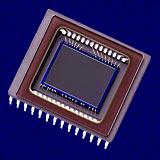|
|
|
Diagram of the human eye, from How the Eye Works |
|
There are more things in Heaven and Earth, Horatio, than are dreamt of in your philosophy |
|
Shakespeare, Hamlet, Act I, Scene v, line 166. |
|
|
|
Diagram of the human eye, from How the Eye Works |
The human eye and a camera are examples of the simplest type of telescope. They consist of two main elements: a lens and a detector. The aperture of a telescope is the diameter of the hole that lets the light in. The aperture of your eye, defined by the pupil, ranges from 2 - 6 mm. The focal length of a telescope is the distance from the lens to the focus; your eye has a focal length of about 5 cm. The detector of your eye is the retina. It consists of some 108 rod cells and 7 x 106 cone cells. The rod cells are more sensitive but do not record color. The cone cells can distinguish among colors but are not so sensitive. That is why you can't see color by moonlight.
A camera works exactly like the eye, but the aperture is typically
bigger. For example, a good 35 mm camera might have a 50 mm lens. Since the
area of a circle is proportional to the square of its diameter, the lens of
such a camera would let in 100 times as much light as your eye when the pupil
is dilated to 5 mm. Get it? (Camera aperture/pupil aperture)2 = (50mm/5mm)2
= 100. Instead of a retina, the camera has film as a detector, and the
light sensitive elements are tiny (5 - 10 micrometer) grains of a silver compound
that turn black when struck by photons. 
But now you can buy a digital camera that works without film. Instead of film, the detector is a CCD. A CCD is a silicon chip that is fabricated so as to have a square (or rectangular) array of tiny independent light-sensitive square patches called pixels. The CCD in a typical digital camera might be a 2.5 x 2.5 cm square chip (about the size of a postage stamp), with 1024 x 1024 = 1.05 x 106 pixels. The image at the right is a typical CCD, about to scale. Each pixel is a square about 25 micrometers on a side. The surface of the CCD appears smooth to the naked eye. The pixels are so small that you can't see them without a microscope.
In the retina of your eye, the pixels are the rod and cone cells (size 1 - 2 micrometers). In film, the pixels are the silver grains (5 - 10 micrometers). So, you can see that technology has a way to go before we can make CCDs with pixels as small as those in the retina of your eye.
(Return to course home page)
Last modified January 18, 2003
Copyright by Richard McCray